Average yield of cucumbers and characteristics of the best varieties
Cucumbers, being a precocious and productive culture, nevertheless, their productivity varies greatly depending on the variety, place of growth and quality of care. The best cucumber varieties for the greenhouse and open ground and their care will be discussed in the article.
How many cucumbers on average can be collected per 1 m²
In order to speak objectively about the yield of cucumber culture per 1 m², you should immediately determine the place of its growth. This is due to the fact that in greenhouses the yield of cucumbers is on average 4 times higher than in open ground.
Did you know? Cucumber is a leader among foods with minimal nutrition. With its 150 kcal present in a whole kilogram of the product, it is included in the human diet solely due to its high and original taste, as well as nutrients.
In addition, the yield of cucumbers in greenhouses, in turn, is influenced by many factors in the form of:
- the correct choice of cucumber varieties;
- competent soil preparation;
- the quality of the seed used;
- optimality of landing without thickening;
- correct watering;
- lighting sufficiency;
- the right choice of temperature;
- timeliness and sufficiency of fertilizing fertilizers;
- disease prevention and pest invasion;
- timely harvesting.

The best crop varieties
Currently, breeders have bred a large number of cucumber varieties that differ in yield, size and shape of the cucumber, its ripening speed, taste, the way of pollination of flowers, the shape of the bush and many other factors. Some are bred specifically for greenhouse cultivation, others are designed for open ground.
Therefore, speaking about how many kilograms of fruit can be removed from 1 square meter, from 1 ha, from 1 hundred parts, from a bush, per month, in the winter, it is necessary to specify the place of growth of cucumber culture, since, as already mentioned, m² in open ground cannot compete in yields with m² in a greenhouse.
Did you know? Cucumbers are leaders among other cultures by the duration of human consumption - almost 6 thousand years.
For the greenhouse
In greenhouses, in the sense of productivity, cucumber varieties, represented by:
- Cupid F1, which is a very productive variety, capable of producing up to 50 kg per 1 m² and characterized by an extremely early ripening period and weak branching, allowing 3 bushes per 1 m² to be grown;
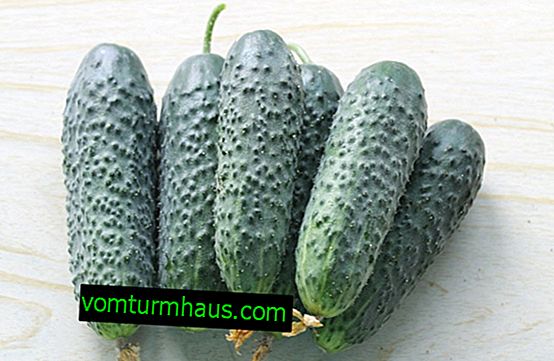
- A boy with a finger, also a ripening variety, starting fruiting on day 38, giving a lot of small fruits, whose weight does not exceed 60 g, and characterized by high resistance to disease;

- Goosebump F1, which does not need to be pollinated by insects and is distinguished by beam flowering, which contributes to a high yield of fruits - up to 28 kg from 1 m² - universal direction;
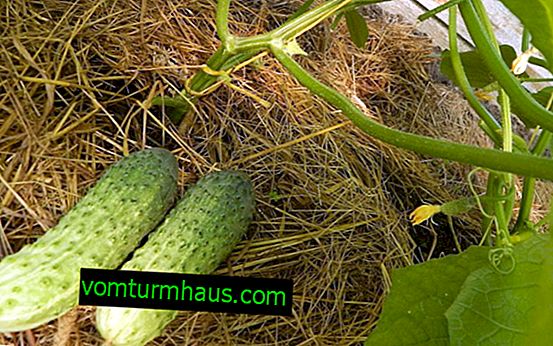
- Benefis F1, which is also a self-pollinated variety, beginning to bear fruit in unison on the 45th day after sowing the seeds and giving up to 25 kg from 1 m² of bitterness-free fruits;
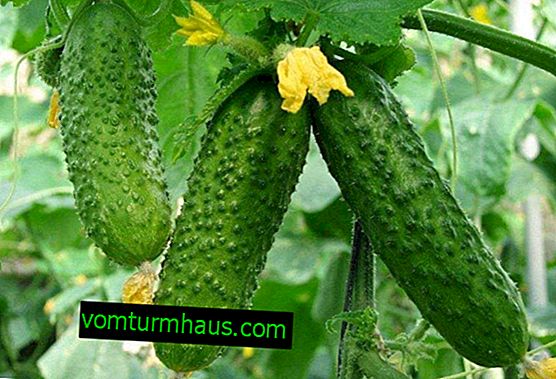
- Tumi, capable of giving up to 11 kg from a bush of delicious cucumbers of a universal direction;
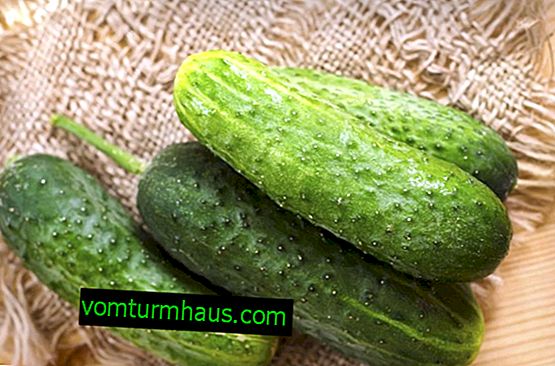
- Matrix, belonging to one of the most popular greenhouse varieties, giving up to 30 kg with 1 m² of non-long fruits and having very good resistance to most cucumber diseases.
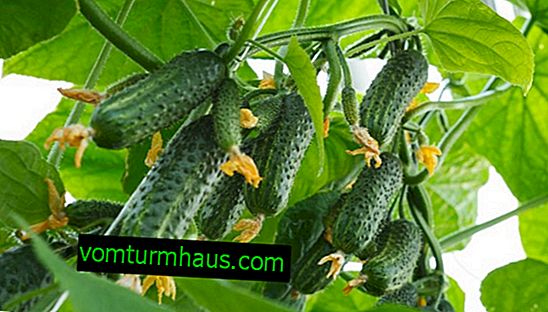
In the open ground
In the open air, the most popular cucumber varieties represented by:
- Noble F1, giving up to 12 kg of universal fruit with 1 m²;
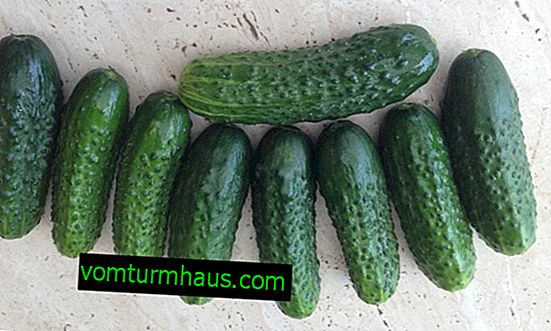
- Fortified F1, characterized by the same yield of oval cucumbers, ideally suited for both raw and salting;
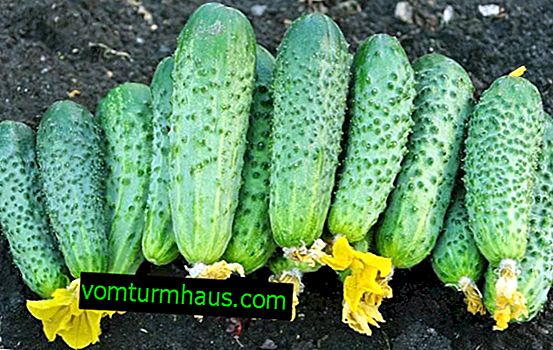
- Claudia F1, capable of producing over 20 kg of 10-cm cucumbers of universal direction with high taste conditions per 1 m²;
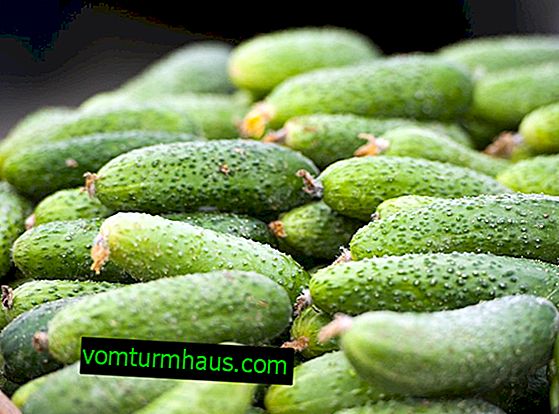
- German F1, characterized by early ripening of small cucumbers, the yield of which reaches 20 kg from 1 m²;
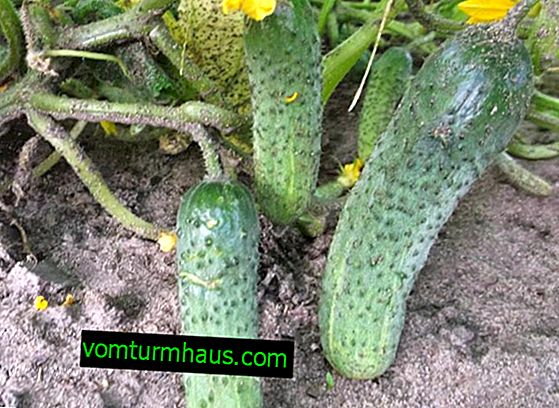
- Champion F1, giving more than 20 kg with 1 m² of dark green fruits for universal use;
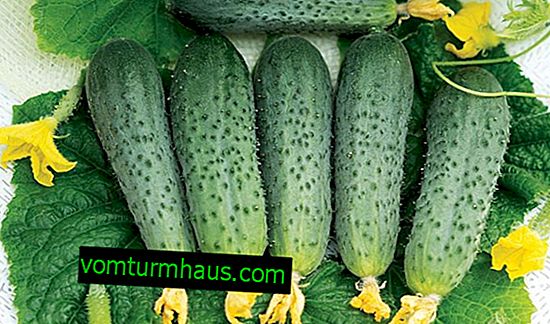
- Cellar F1, which has earned popularity for its very salting fruit with white stripes on its sides and brown spikes.

How to grow cucumbers
Even with a successfully selected cucumber variety, the final result still largely depends on the competent cultivation of the crop.
Root system strengthening
Cucumber plants have a rather weak root system, which is easily damaged when the soil is loosened, and when the soil temperature drops to + 13 ° C, it can die at all. There are several ways to increase the root system of cucumbers and strengthen it.
In the first method, you must:
- Half fill the containers in which the cucumber seeds are planted.
- Cover the containers with glass or film and place in a warm place.
- When seedlings are pecked after about 4 days, the coating from the containers is removed, and they themselves are placed on the windowsill.
- As the seedlings grow, a substrate is poured into the container until it completely fills it.
Important! The best indicator of the moisture state of the soil under the plants is cucumber leaves. If there is a lack of moisture in the soil, then they acquire a dark shade and become brittle, and when there is an excess of moisture, they become pale green.
With the second method of strengthening the root system, you should:
- When 2 real leaves appear on the sprouts, get the seedlings from the container together with an earthen lump and transplant into a large container, also half filled with substrate.
- As seedlings grow, constantly add soil to the tank.
- In parallel, prepare a place for planting seedlings.
During the strengthening and development of the root system in a third way, you need:
- Dig holes on a prepared bed of a depth approximately 2 times greater than the height of an earthen coma near seedlings.
- Get seedlings from the container along with an earthen lump and place in the hole.
- Sprinkle the earth lump from the sides with soil flush with the top of the lump.
- Then lay a layer of straw 8–10 cm thick on top and fill it with soil to the top of the hole and thoroughly water it.

Watering
Seedlings planted in the soil must be watered only after a few days after acclimatizing it in a new place. But after this, the cucumber bush requires constant moisture in the soil, which, however, should by no means reach overmoistening. Especially increases the need for moisture in the plant during the formation of the fruit.
It is best to water the plants in the morning or in the evening with warm, settled water. It is recommended to combine watering with fertilizing fertilizers. It helps to maintain optimal temperature and humidity conditions in the soil, mulching with the help of hay, straw, overripe sawdust.
Find out in more detail how to water cucumbers in the greenhouse correctly and how often.
Top dressing
During the growing season, cucumber plants require up to 5 fertilizing with organic and mineral fertilizers:
- During flowering, the first top dressing is carried out. To prepare it, add 10 g of superphosphate, potassium sulfate, urea and 1 cup of mullein to a bucket of water.
- With the advent of the first fruits, the soil is enriched with 1 glass of chicken droppings and 15 g of nitrophoska dissolved in a bucket of water.
- After half a month, for each m² of soil, 6 l of a solution prepared from 10 g of potassium sulfate and 0.6 l of mullein added to a bucket of water are added.
- After another half a month, 15 g of nitrophoska, 0.6 l of chicken droppings or mullein should be diluted in a bucket of water and water 9 l of the resulting mixture each m².

At the beginning of flowering, the cucumber bush also needs potassium, phosphorus and manganese, which are delivered to plants using foliar feeding with a mixture of 35 g of superphosphate and a bucket of water, as well as 10 g of boric acid and 15 crystals of potassium permanganate dissolved in 1 liter of water. Foliar top dressing is carried out by spraying solutions on the leaf surfaces of the bushes.
Important! Despite the usefulness of foliar dressing, it is not able to replace the root one and therefore serves only as an auxiliary, and not the main type of fertilizer.
Useful tips gardeners
Experienced vegetable growers advise:
- during active fruiting, collect fruits from cucumber lashes daily, so that the plant does not cease to bear fruit;
- as an additional top dressing, use air, carried out using a barrel filled with water and organics, which during fermentation emit carbon dioxide and nitrogen into the atmosphere of the greenhouse, which are so useful for plants;
- stop watering for a short time, then resuming it again, so that, with the help of the stress received by the plant, it encourages it to actively produce female flowers, not empty flowers;
- Do not store cucumber fruits next to other vegetables and fruits, which, secreting ethylene, accelerate overriding of cucumbers;
- do not keep cucumbers before storage for a long time in a warm place and in a brightly lit place, as this significantly worsens the consumer condition of the fruit.
















